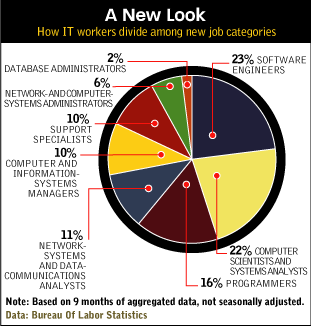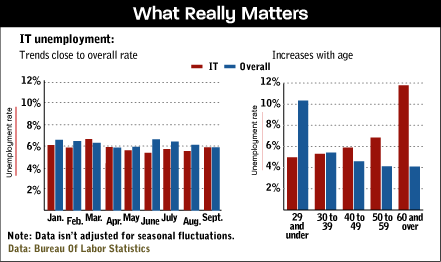Jobless RecoveryJobless Recovery
IT isn't producing more jobs, but new data shows some categories fare worse than others

You already know the employment situation is bad; now the data is available to show the true state of the business-technology job market. information's analysis of newly parsed government data provides an eye-opening picture of IT employment. If you're a computer programmer or a database administrator, you face jobless rates higher than the general workforce. The same applies if your college degree dates from around 1970 or earlier. But the situation is better than average if you're a business-technology manager, computer scientist, or software engineer.
These are pieces of the picture emerging from new employment data that dissects the workforce into jobs that more closely reflect the real state of business computing. Since January, the U.S. Census Bureau has used eight job categories to collect employment information on business-technology workers. The categories include jobs not defined under the old three-category system, such as computer and information-systems managers, software engineers, support specialists, and database administrators.
The old system, in use for more than a decade, counted only systems analysts, programmers, and computer operators, the dominant job categories at a time when most commercial computing was done on mainframes. As new jobs emerged, they were subsumed into one of the original categories or counted as part of other professions.
Nine months of data collected under the new system shows that, like much of the rest of the economy in this "jobless recovery," the IT sector hasn't added jobs this year. It had 3.3 million people employed in January and February and 3.2 million in September.

 The new data pegs the average monthly IT jobless rate at 5.8%, marginally better than the 6.1% unemployment rate for all Americans during the same period. That rate, so close to the overall percentage, is in stark contrast to the situation a few years ago, when IT unemployment was regularly several percentage points lower than the overall rate.
The new data pegs the average monthly IT jobless rate at 5.8%, marginally better than the 6.1% unemployment rate for all Americans during the same period. That rate, so close to the overall percentage, is in stark contrast to the situation a few years ago, when IT unemployment was regularly several percentage points lower than the overall rate.
In specific categories, the data reveals that programmers face the highest jobless rate at 7.1%, and database administrators are next at 6.6%. At the other end, computer scientists and systems analysts have a 5.1% unemployment rate and software engineers 5.4%
What the numbers don't show is that for individuals with specific in-demand skills, the hiring picture may be improving. There's been an uptick in demand for people with Microsoft .Net and other software development skills and those with experience using business-intelligence products from vendors such as Business Objects, Cognos, and SAS Institute, says Ryan Gilmore, a branch manager for IT temporary staffing firm Robert Half Technology. "People who know how to use technology to help their companies make better strategic business decisions are in demand," he says.
People with experience beyond IT are getting hired, Gilmore says. For example, people with IT plus a finance background are sought to fill IT-audit positions related to the Sarbanes-Oxley Act financial-reporting regulations for public companies.
And this should help: IBM last week revealed plans to recruit 10,000 specialists in areas such as Linux development, middleware technologies, and professional services (see story, "IBM Goes Headhunting").
Household International Inc. increased its IT staff by about 11% since January, adding 267 people. Experienced project managers are among the people the financial-services company is looking for. But competition is tough: Household International gets about 100 resumés for every open position. Sutter Health, which operates health-care facilities in Northern California, has had a different experience. It has had difficulty filling 35 IT positions, some of which have been open for six months, says John Hummel, senior VP and CIO. The jobs range from Web programmers to Six Sigma-type process engineers. "Bottom line is that we're hiring and expect to increase hiring in 2004," Hummel says.
Online job-search company Monster reports a pickup in the number of tech jobs being posted on its Web site. Hardware postings were up 33% from August to September and software jobs 28%. "There's been a fairly dramatic increase. ... People are getting jobs again," says Jeff Taylor, founder and "chief monster" at the Monster Worldwide Inc. division.
While there's some upward movement in demand for IT talent, "there's still a larger supply than demand," says Robert Half's Gilmore, and "it's still a buyers' market." Offshore outsourcing is partly to blame, he says. But it isn't just foreign service providers that are making it hard for programmers, in particular, to find work. Relatively high unemployment in that job category can also be attributed to companies relying more on packaged software than developing their own programs.
One message is clear: To stay employed, you've got to stay current. Men's clothing retailer Casual Male Retail Group Inc. is slowly whittling down its IT workforce, which has about 65 people, because it's moving off a mainframe environment to distributed computing. "You've got experts in Cobol who can't do much else," says Ken Goldstein, an economist at the Conference Board. "Imagine being 55 years of age and being told you don't have a job."
Unemployment of IT workers age 60 and over approached 11.8% in the first nine months, more than double the nearly 5% rate of the 29-and-under crowd (see chart, above). That's the opposite of the overall U.S. workforce, where the jobless rate decreases with age, starting at 10.3% for people 29 and under and decreasing to 4.1% for those over 60.

Business-technology managers fare better than most other IT job categories. But their 5.6% unemployment rate pales in comparison with managers in the overall workplace, who boast a 2.9% rate.
And the harsh reality is that the longer you're out of work, the harder it is to get rehired. A lot can happen if a worker steps out of the workforce for several months, says Dennis Hernreich, executive VP, chief operating officer, and CFO at Casual Male, and it can be hard to keep up with the various certifications and accreditations needed to be competitive. "IT is a constantly changing, dynamic, moving area of business," Hernreich says. In that regard, the fast-paced environment that attracts so many people to careers in business technology in the first place can work against those who fall behind.
-- with Beth Bacheldor and Marianne Kolbasuk McGee
About the Author
You May Also Like






